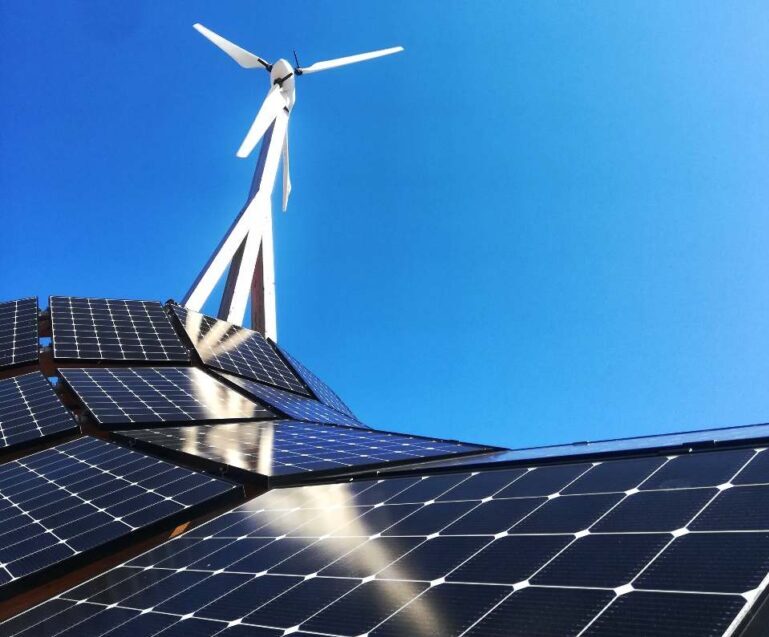Renewable energy has become mainstream in India. The segment has registered tremendous growth and potential. From residential complexes adopting solar energy to industry-scale adoption of green energy, the country is at the cusp of registering ROI on its total cost of investments in RE.
In the total installed capacity of 429 GW, RE constitutes around 44% of India’s energy mix, including large hydro. Which translates to 190 GW of renewables.
Cumulative Physical Progress as of December 2023:
| Sector Achievements (April – January 2023) FY- 2023-24 | Cumulative Achievements (as of 31.01.2024) | |
| I. Installed RE Capacity (MW) | ||
| Wind Power | 2336.1 | 44969.23 |
| Solar Power* | 7526.15 | 74306.52 |
| Small Hydro Power | 50.45 | 4994.75 |
| Biomass (Bagasse) Cogeneration | 0.00 | 9433.56 |
| Biomass(non-bagasse)Cogeneration | 13.80 | 828.25 |
| Waste to Power | 1.60 | 249.74 |
| Waste to Energy (off-grid) | 28.41 | 334.31 |
| Total | 9956.51 | 135116.36 |
Source: Ministry of New and Renewable Energy
Over the next two write-ups, WriteCanvas will highlight the details of each market segment, including market share, installed capacity of the renewal energy, and largest deployments. The objective is not to overburden you with data and numbers. The idea is to take renewable energy conversations beyond boardrooms to ground zero and beyond.
This means tying renewable energy with all the other elements, such as carbon emissions, climate change, and biodiversity, to an overall sustainable, green planet.
The focus today is on solar, wind, and hybrid energy:
Solar energy: India added 7.5 GW of solar capacity in 2023, a drop of 44% compared to the previous year’s installations of 13.4 GW, according to a Mercom India Research report. Solar accounted for 16.4% of the overall power mix and 39.4% of the total installed renewable energy capacity at the end of Q3 2023, according to recent data from the CEA, the Ministry of New and Renewable Energy (MNRE), and Mercom’s India Solar Project Tracker.
Largest solar power plant: The Bhadla Solar Park is a solar power plant located in the Thar Desert of Rajasthan, India. It covers an area of 56 square kilometres and has a total installed capacity of 2,245 megawatts (MW), making it the largest solar park in the world as of 2023.
Target: In the last five years, the country’s solar installed capacity has experienced a monumental transformation, increasing from 21,651 MW to 70,096 MW in 2023. With ambitious targets and policies like the Production Linked Incentive (PLI), India is propelling itself to achieve 500 GW of renewable energy capacity by 2030.
Wind power: According to the Ministry for New & Renewable Energy and Power, the installed wind energy generation capacity of the country was 43,773 MW, as of 30th June 2023. (check above for the latest numbers) During FY 2022-23, the quantum of electricity generated from wind energy in the country was 71,814 million units
Largest wind power project: The Muppandal Wind Farm is India’s largest operational onshore wind farm. This project is located in Kanyakumari district, Tamil Nadu. The project was developed by the Tamil Nadu Energy Development Agency. Its installed capacity is 1,500 MW, which makes it the 3rd-largest operational onshore wind farm in the world.
Target: As per Global Wind Energy Council-India, the Indian offshore wind market is expected to accelerate towards 2027 with annual installations increasing from 1.8 GW in 2022 to 2.8 GW in 2023, 3.7 GW in 2024, and peaking at 5 GW in 2025 in base case. Overall, India’s wind market offers an opportunity for 21.1 GW of installations from 2023-2027
Solar-wind hybrid power: Wind-Solar Hybrid Policy: In 2018, a national policy was announced to promote an extensive grid-connected wind-solar PV hybrid system for efficiently utilizing transmission infrastructure and land. A way to address the intermittency challenge of one renewable power source is to combine solar and wind, achieving better grid stability. It provides flexibility in a share of wind and solar components in the hybrid project; however, the capacity of one resource must be at least 25% of the rated power capacity of other resources.
Largest project: Adani Green Energy has launched its 700-MW hybrid green energy project in Jaisalmer, Rajasthan, making its total renewable portfolio in India the largest at 8,024 MW. The project, which consists of 600 MW solar and 510 MW wind plants, is the world’s largest of its kind. It uses advanced renewable technologies like bifacial solar PV modules and horizontal single-axis trackers to maximize electricity generation. The plant is designed to deliver a capacity utilization factor of at least 50%, making it a reliable solution for India’s growing power demand. The project, located in Jaisalmer, Rajasthan, is the company’s fourth wind-solar hybrid power plant and is the world’s largest of its kind.
Our take:
Though India has ambitious capacity addition plans, they lack implementation and other bottlenecks, like evacuation issues.
These are exciting times for the renewable energy segment in India. The first two blogs in the series spotlight the policies trends and opportunities in the segment. Financial sentiments, along with closer scrutiny of how the manufacturing-to-user supply chain executes the project, will ultimately determine faster/slower adoption of the RE alternate.

